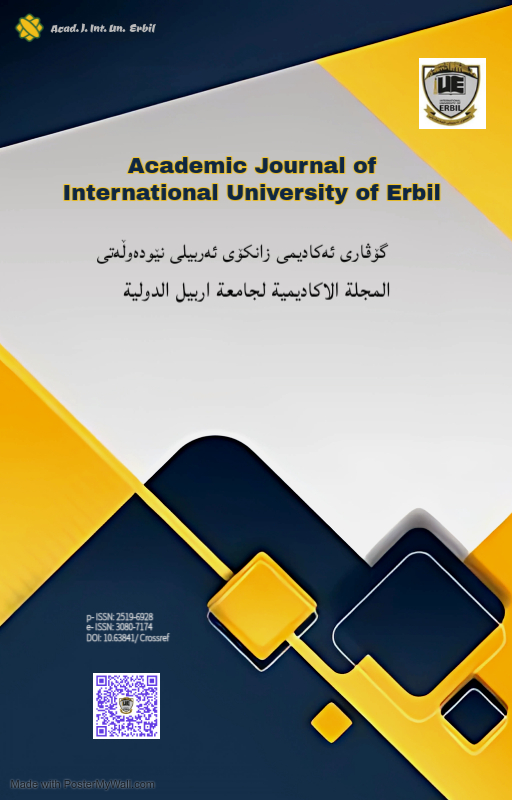A Hybrid Algorithm for Scalable Friend Recommendation in Large-Scale Social Networks
A Hybrid Algorithm for Scalable Friend Recommendation
DOI:
https://doi.org/10.63841/23576Abstract
The rapid growth of online social networks has led to a surge in user-generated data, resulting in significant information overload and making accurate friend recommendations increasingly difficult. Traditional recommendation methods—such as social graph analysis, collaborative filtering, and semantic similarity—struggle to scale effectively in large-scale environments due to high computational costs or limited precision. This research proposes a hybrid algorithm that combines location-based proximity detection and user classification to enhance the accuracy and scalability of friend recommendations. By identifying geographically or behaviorally close user clusters and separating distinct user classes, the system can efficiently uncover potential social connections. Experimental results demonstrate that the proposed method improves friend suggestion relevance while reducing computational overhead, making it suitable for large and dynamic social platforms.
References
P. Zhang, S. Yu, Y. Zeng, & M. Li, “Analysis of a New Kind of Memcapacitor,” Physica A: Statistical Mechanics and its Applications, vol.387, no.12, pp.2975-2982, 2008.
M. Kiełbasiński, A. Pacut, & T. Skotnicki, “Optimization of Power Parameters of an Energy Storage System Based on a Supercapacitor in an Electric Vehicle,” in 2011 International Conference on Electrical Machines and Systems (ICEMS), Beijing, China, pp.1-5, 2011.
T. Kanungo, D. M. Mount, N. S. Netanyahu, C. D. Piatko, R. Silverman, & A. Y. Wu, “A local search approximation algorithm for k-means clustering,” Proceedings of the eighteenth annual symposium on Computational geometry - SCG ’02, 2002, doi: https://doi.org/10.1145/513400.513402.
J. Jeong, M. So, & H.-Y. Hwang, “Selection of Vertiports Using K-Means Algorithm and Noise Analyses for Urban Air Mobility (UAM) in the Seoul Metropolitan Area,” Applied Sciences, vol.11, no.12, pp. 5729, 2021, doi: https://doi.org/10.3390/app11125729.
A. Gupta & K. Tangwongsan, “Simpler Analyses of Local Search Algorithms for Facility Location,” arXiv.org, Sep. 15, 2008. https://arxiv.org/abs/0809.2554 (accessed May 03, 2024).
C.-N. Huang, & C.-T. Chan, “ZigBee-based indoor location system by k-nearest neighbor algorithm with weighted RSSI,” Procedia Computer Science, vol. 5, pp. 58–65, 2011, doi: https://doi.org/10.1016/j.procs.2011.07.010.
G. Zhang, Y. Li, C. Yan, & S. Li, "Energy-Efficient Scheduling for Wireless-Powered Internet of Things with Energy Harvesting," in IEEE Internet of Things Journal, vol.7, no.4, pp. 3385-3395, 2020.
R. Adam, & P. Chi, "Deep Learning-Based Automatic Modulation Classification for Cognitive Radio Networks," in IOP Conference Series: Earth and Environmental Science, vol.587, no.1, pp. 012120, 2021.
H. Ma, & X. Zhou, “A GPS location data clustering approach based on a niche genetic algorithm and hybrid K-means,” Intelligent Data Analysis, vol.23, pp.175-198, Jun. 2019, doi: https://doi.org/10.3233/ida-192791.
K. Krishna, & M. Narasimha Murty, “Genetic K-means algorithm,” IEEE Transactions on Systems, Man and Cybernetics, Part B (Cybernetics), vol. 29, no.3, pp.433-439, 1999, doi: https://doi.org/10.1109/3477.764879.
R. Mishra, V. K. Jain, & A. K. Verma, “Performance Analysis of Multi-Hop Cellular Networks with Mixed RF/FSO Links,” in IEEE Transactions on Communications, vol.67, no.9, pp.6461-6475, 2019.
M. M. Abdoel Wahid, “Determining The Location Of RMU, Using K-Means Clustering, Evaluate The Location Of Existing RMU, Using R-Programming,” Journal of Informatics and Telecommunication Engineering, vol.6, no.1, pp. 10-17, 2022, doi: https://doi.org/10.31289/jite.v6i1.6126.
W. Wang, L. Tao, C. Gao, B. Wang, H. Yang, & Z. Zhang, “A C-DBSCAN Algorithm for Determining Bus-Stop Locations Based on Taxi GPS Data,” Lecture notes in computer science, pp.293-304, 2014, doi: https://doi.org/10.1007/978-3-319-14717-8_23.
Y. Wen, B. Wang, & H. Yuan, “A multi-objective optimization algorithm based on particle swarm optimization for RF coverage and throughput in heterogeneous networks,” Journal of Network and Computer Applications, vol.143, pp. 37-45, 2019.
K. B. Tayyaba, T. R. Ahmed, S. Z. Zahra, & M. S. Ali, “Analysis of Road Accident Locations Using Geographic Information System (GIS) Techniques: A Case Study of Karachi, Pakistan,” in International Journal of Transportation Engineering and Technology (IJTET), vol.4, no.1, pp.1-11, Jan. 2018. Available: https://www.academia.edu/download/57082314/4599.pdf.
D. Birant, & A. Kut, “ST-DBSCAN: An algorithm for clustering spatial-temporal data,” Data & Knowledge Engineering, vol. 60, no.1, pp.208-221, 2007, doi: https://doi.org/10.1016/j.datak.2006.01.013.
S. R. Gubbala, S. A. Alshehri, A. S. Almansouri, & M. K. Hasan, “Performance analysis of massive MIMO systems with ZF precoding in the presence of transceiver impairments,” in 7th International Conference on Computer and Communication Engineering (ICCCE), Kuala Lumpur, Malaysia, pp.308-313, 2018
Z. Wen, Z. Wang, & X. Xu, “Prediction of the collapse height of rubble piles using a hybrid neural network,” Advances in Engineering Software, vol.164, pp.102992, 2022.
M. Z. Hossain, N. Nahar, M. T. Haque, & M. S. Islam, “Robust Iterative Learning Control for Uncertain Nonlinear Systems,” in IEEE Transactions on Systems, Man, and Cybernetics: Systems, vol.51, no.2, pp.1132-1143, 2021.
H. A. Abbas, S. A. Mohammed, & A. A. Hassan, “Design and Implementation of a Smart Traffic Light Control System Based on Image Processing Techniques,” International Journal of Advanced Computer Science and Applications (IJACSA), Accessed on: May 3, 2024.
K. M. Hama Karim, “Link Prediction in Dynamic Networks Based on the Selection of Similarity Criteria and Machine Learning,” UHD Journal of Science and Technology, vol.7, no.2, pp.32-39, 2023.
A. El-Safty, M. El-Sahn, & M. K. El-Sherbeni, “Miniaturized Planar Antennas with Stable Radiation Characteristics Over Wide Bandwidths,” IEEE Transactions on Antennas and Propagation, vol.67, no.4, pp.2466-2474, 2019.
N. E. Elhoseny, S. M. Riad, M. K. Hassan, A. S. El-rabaie, & M. Abdelrazek, “Efficient technique for MRI brain tumor detection using neural network,” Applied Intelligence, vol.48, no.9, pp.2595-2605, 2018.
K. Kanagasabai, P. T. Vanathi, “Location-aware cluster-based routing in wireless sensor networks,” International Journal of Communication Networks and Distributed Systems, vol.26, no.2, pp.123-135,2021.
J. Sampaio, C. Lago, L. Casais, & N. Leite, “Effects of starting score-line, game location, and quality of opposition in basketball quarter score,” European Journal of Sport Science, vol.10, no.6, pp.391-396, 2010, doi: https://doi.org/10.1080/17461391003699104.
M. G. Ferrari, F. Mannocci, & S. A. Vichi, “A clustering procedure for the estimation of fibre direction in three-dimensional images from X-ray microtomography,” Journal of Microscopy, vol.244, no.1, pp.1-10, 2011.
S. Xie, Y. Yao, & Y. Zhang, “Research on Location-Based Access Control Model for Web Services,” in Proceedings of the 7th International Conference on Intelligent Information Processing, IIP 2014, Hangzhou, China, pp. 239-248, 2014.
Y. A. Siddiqi, M. Gondal, & R. A. Khan, “An efficient secure authentication protocol for wireless body area sensor networks,” Wireless Personal Communications, vol.82, no.4, pp.2677-2696, 2015.
Kakarash, Z.A., Karim, S.H.T., Ahmed, N.F. & Omar, G.A., “New topology control base on ant colony algorithm in optimization of wireless sensor network,” Passer Journal of Basic and Applied Sciences, vol.3, no.2, pp.123-129. 2021.
Downloads
Published
Issue
Section
License
Copyright (c) 2025 Academic Journal of International University of Erbil

This work is licensed under a Creative Commons Attribution-NonCommercial-NoDerivatives 4.0 International License.












